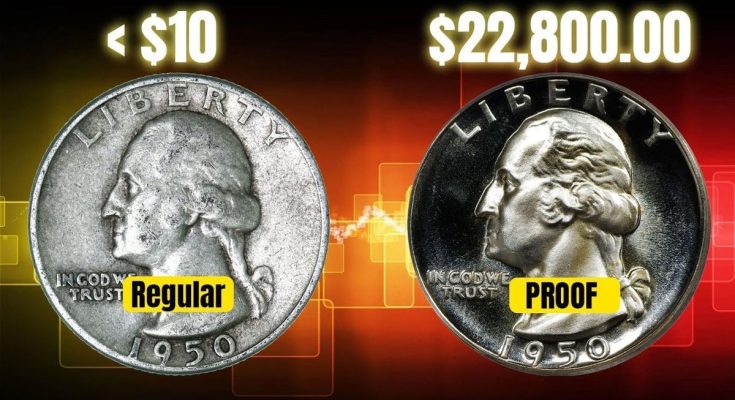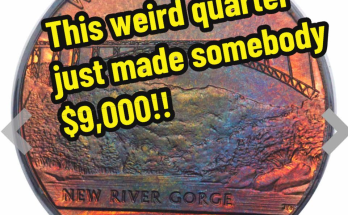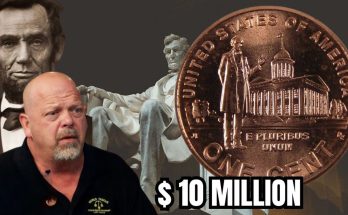💰 Plain Coin vs. Proof Coin – What’s the REAL Difference (and Why is One Worth $22,800)?
The image you see is a perfect illustration of one of the most significant value distinctions in coin collecting: the difference between a Regular (Business Strike) Coin and a Proof Coin. On the left, a standard 1950 Washington Quarter, likely worth just a few dollars above its silver melt value, is contrasted with the specimen on the right—a 1950 Proof Quarter graded in top condition, which has sold at auction for an astonishing $22,800.00.
This dramatic price gulf isn’t about an error; it’s about the method of manufacture. “Proof” is not a grade; it’s the highest quality striking process the U.S. Mint employs, transforming an ordinary piece of currency into a miniature work of art intended solely for collectors.
Understanding the “Regular” (Business Strike) Coin
The coin on the left, labeled “Regular,” is what numismatists call a Business Strike coin. This is the currency mass-produced for circulation in commerce (hence the name “business”).
- Production: These coins are struck at high speed, often once, using working dies. The focus is on efficiency and durability, ensuring millions can be produced quickly.
- Appearance: Their finish is typically uniform, showing a modest, slightly satiny luster. They may have slight imperfections, known as “bag marks,” which are minor nicks and scratches from coins bumping into each other in large canvas bags during transport.
- Rarity/Value: Millions (or even hundreds of millions) of business strike quarters were made in 1950. While the coin shown is 90% silver and therefore holds an intrinsic value, its collectability is relatively low unless it is a rare error or is preserved in near-perfect, uncirculated condition. A circulated 1950 quarter is commonly valued at under $10, primarily for its silver content.
The Exquisite Craftsmanship of the “PROOF” Coin
The coin on the right, displaying the stunning price tag of $22,800, is a Proof Coin. This is where the world of currency meets fine art. Proof coins are specially made, often at a different facility (like San Francisco, often noted by an ‘S’ mintmark on later issues, though 1950 Proofs were made in Philadelphia), and are never intended to circulate.
1. The Specialized Striking Process
The key difference lies in the meticulous, almost handcrafted production method:
- Dies: The dies (the metal pieces used to stamp the design) are specially polished to a mirror-like sheen.
- Planchets (Blanks): The blank coin discs are also hand-polished and chemically treated before striking.
- Multiple Strikes: Proof coins are struck twice or more under higher pressure. This extra contact ensures the design elements are fully brought up, resulting in razor-sharp details that are far superior to a single-strike business coin.
- Handled with Care: Each proof coin is inspected and handled individually with gloves before being sealed into protective packaging.
2. The Defining Visuals (Cameo Effect)
The striking process gives a proof coin its signature look, known as the Cameo Effect:
- Mirror Fields: The flat background areas, called the “fields,” appear highly reflective, like a mirror.
- Frosted Devices: The raised design elements (like George Washington’s portrait, known as the “device”) have a textured, slightly matte, or “frosted” finish.
When these two elements contrast dramatically, it creates the highly sought-after Deep Cameo (DCAM) or Ultra Cameo (UCAM) effect.
3. The Astronomical Value
The $22,800 price point for the 1950 Proof Washington Quarter is not for a “Regular Proof,” which might sell for a few hundred dollars. This staggering valuation belongs to an exceptionally rare subset: the 1950 Proof Quarter in a high-grade Deep Cameo (DCAM) condition.
- Scarcity: Only 51,386 Proof Sets were minted in 1950—a tiny fraction of the millions of circulating quarters. Of those, only a handful (estimated to be in the low dozens) exhibit the intense, frosty-white contrast required for the DCAM designation.
- Condition is King: The featured coin is likely graded PR-67 or higher on the numismatic scale, meaning it is virtually flawless. The combination of its extreme rarity (DCAM status) and its perfect preservation (high Proof grade) is what drives the coin’s value into the tens of thousands.
How to Spot the Difference
The primary way to distinguish a Proof coin is to look for the mirrored fields and frosted devices. When you tilt the coin, the background will reflect like a glass mirror, and the portrait will stand out in sharp, frosted relief. If your coin is a 1950-era quarter with this dramatic contrast, you need to have it professionally authenticated and graded immediately—you could be holding the next $22,800 treasure!
Would you like to search for the specific auction record for the 1950 Washington Quarter Deep Cameo (DCAM) to confirm the highest recorded sale price?



